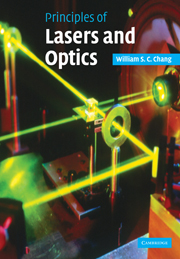Book contents
- Frontmatter
- Contents
- Preface
- 1 Scalar wave equations and diffraction of laser radiation
- 2 Gaussian modes in optical laser cavities and Gaussian beam optics
- 3 Guided wave modes and their propagation
- 4 Guided wave interactions and photonic devices
- 5 Macroscopic properties of materials from stimulated emission and absorption
- 6 Solid state and gas laser amplifier and oscillator
- 7 Semiconductor lasers
- Index
- References
2 - Gaussian modes in optical laser cavities and Gaussian beam optics
Published online by Cambridge University Press: 06 July 2010
- Frontmatter
- Contents
- Preface
- 1 Scalar wave equations and diffraction of laser radiation
- 2 Gaussian modes in optical laser cavities and Gaussian beam optics
- 3 Guided wave modes and their propagation
- 4 Guided wave interactions and photonic devices
- 5 Macroscopic properties of materials from stimulated emission and absorption
- 6 Solid state and gas laser amplifier and oscillator
- 7 Semiconductor lasers
- Index
- References
Summary
It is well known that basic solid state and gas laser cavities consist of two end reflectors that have a certain transverse (or lateral) shape such as a flat surface or a part of a large sphere. The reflectors are separated longitudinally by distances varying from centimeters to meters. The size of the end reflectors is small compared with the separation distance. All cavities for gaseous and solid state lasers have slow lateral variations within a distance of a few wavelengths (such as the variation of refractive index and gain of the material and the variation of the shape of the reflector). Therefore these cavity modes are analyzed using the scalar wave equation. Laser cavities are also sometimes called Fabry–Perot cavities because of their similarity to Fabry–Perot interferometers. However, Fabry–Perot interferometers have distances of separation much smaller than the size of the end reflectors. The diffraction properties of the modes in Fabry–Perot interferometers are quite different from the properties of modes in laser cavities.
The analysis of the resonant modes is fundamental to the understanding of lasers. Modes of solid state and gas lasers are solutions of Eqs. (1.28a) and (1.28b), known as Gaussian modes. They are TEM modes. The analysis of laser modes and Gaussian beam optics constitutes a nice demonstration of the mathematical techniques presented in Chapter 1.
- Type
- Chapter
- Information
- Principles of Lasers and Optics , pp. 34 - 71Publisher: Cambridge University PressPrint publication year: 2005

